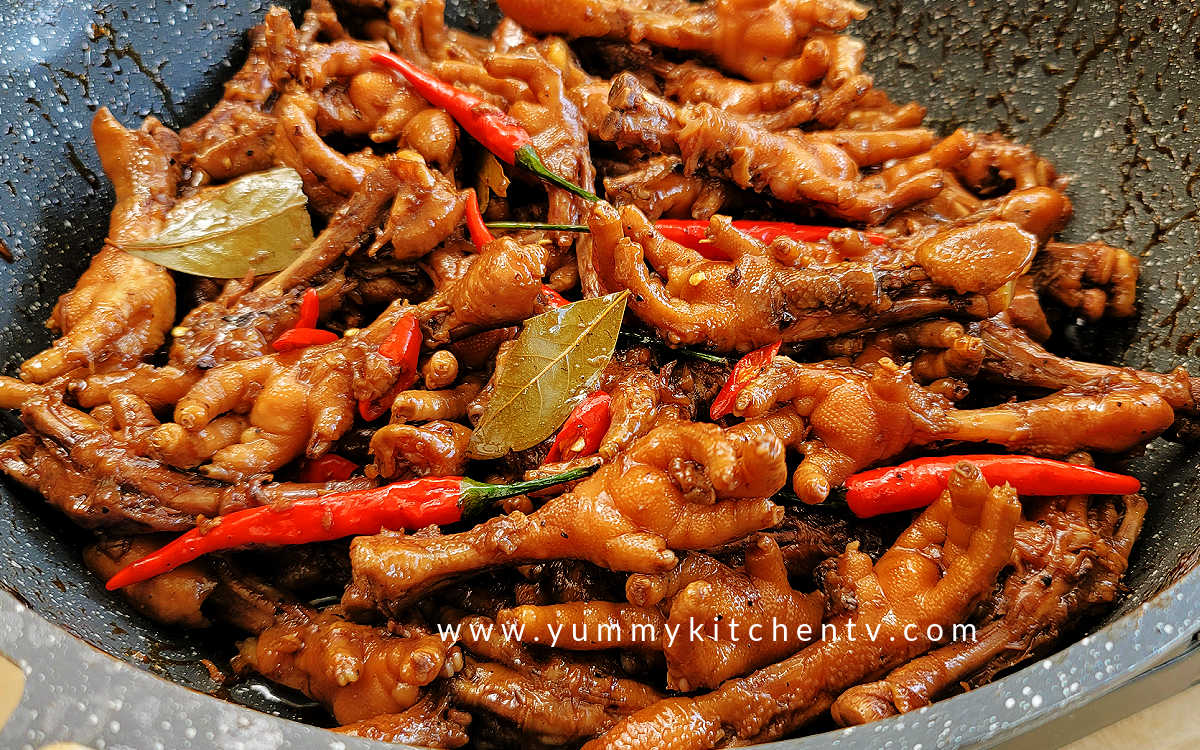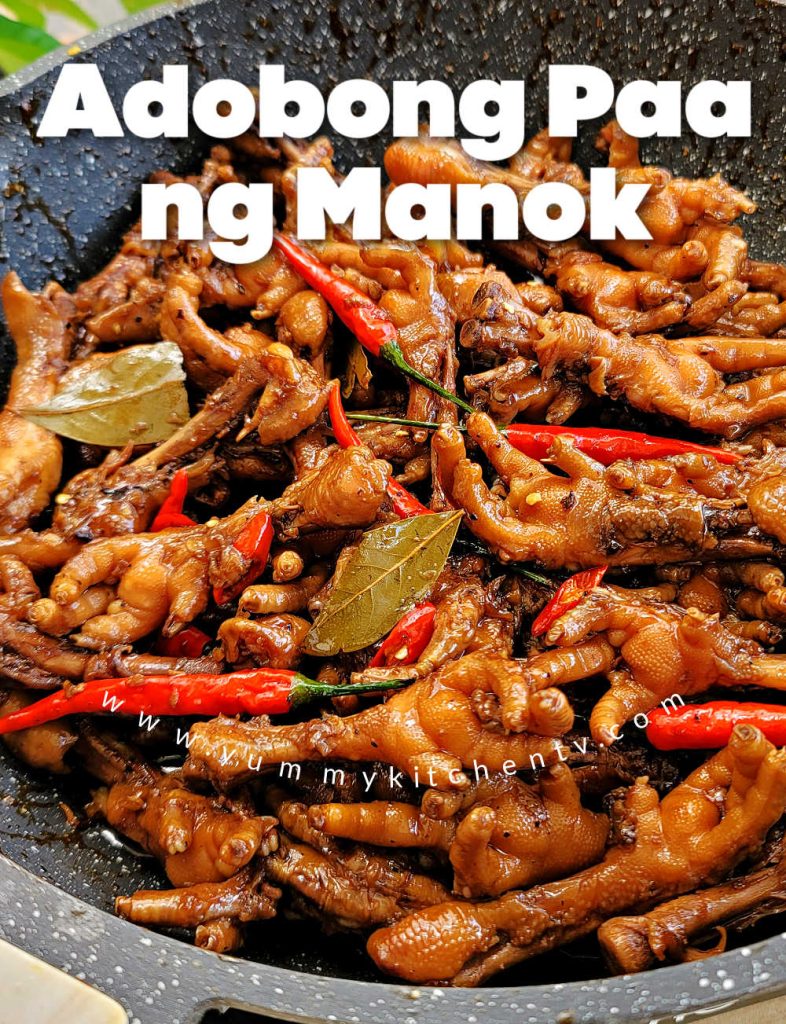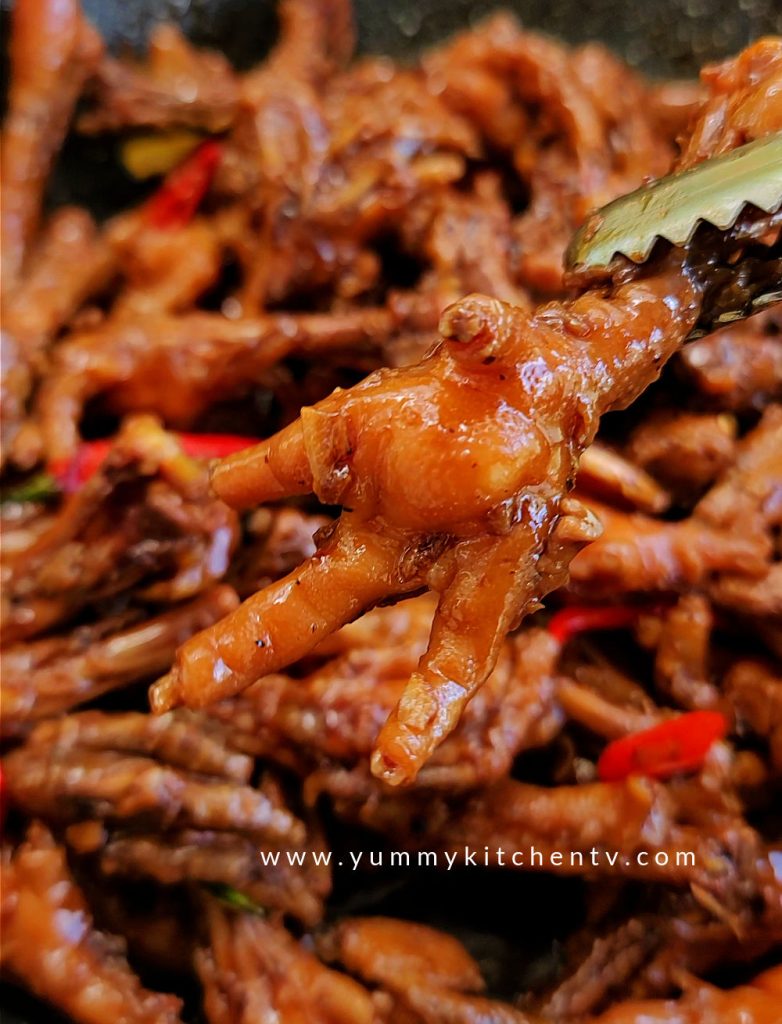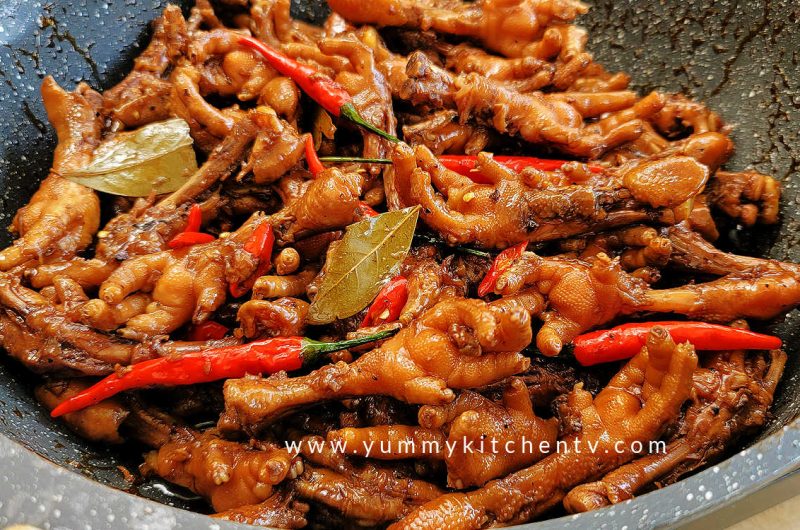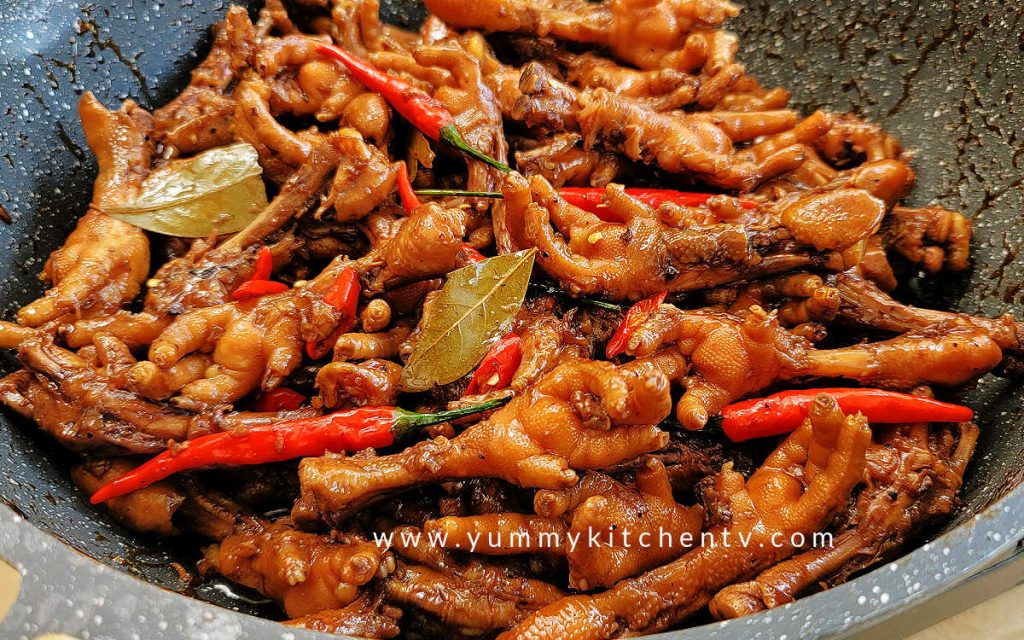Adobong paa ng manok (chicken feet adobo) is a Filipino dish made by cooking Chicken feet in a sauce made with soy sauce, vinegar, garlic, onion, black pepper, sprite, ginger, bay leaves, red chilies and oil. It is best eaten using with your bare hands. If you haven’t tried chicken feet adobo yet, then you’re totally missing out a lot in life! This quick and easy adobo recipe is a great starter if you want to try one out. Unlike the usual juicy and crispy fried chicken wing or leg, chicken feet is uniquely soft due to its high collagen content, making it gelatinously soft and tender. Trying out this adobong paa ng manok will definitely be a life changer.
Adobong Paa ng Manok Recipe
Ingredients:
- 2 kilos chicken feet
- 2/3 cup soy sauce
- 2/3 cup vinegar
- 1 bulb garlic (minced)
- 1 large onion (sliced)
- 1 teaspoon black pepper
- 1 cup Sprite (or 7up)
- 1 thumb ginger
- 4 to 5 pieces dried bay leaves
- 2 to 3 cups hot water
- Lots of red chilies
- Oil for sauteing
Directions:
- Grab the chicken feet and put them in a large bowl. Sprinkle a lot of salt and then rub and massage them for a few minutes. Then, cut the nails. Wash them one more time and then rinse well.
- Prepare a pot of boiling water and parboil the chicken feet for around 10 minutes. After parboiling, drain the chicken feet and discard the boiled water. Set the chicken feet aside.
- Grab another pan and drizzle some oil to heat it up for a few minutes. Add the garlic and onions and saute them for a few minutes. Then, add the chicken feet and saute for a whole minute.
- Sprinkle with black pepper. Season with the soy sauce, oyster sauce and dried bay leaves. Saute them for a few minutes before adding the vinegar. After adding the vinegar, let it simmer for 3 minutes before stirring again.
- Then, add the lime soda and hot water to cook the chicken feet fully. Cover the pot and allow them to simmer until soft and almost gelatinous.
- After around 45 minutes of cooking, add the chilies (chopped and whole) depending on your spice level preference.
- Do a taste test to check if the flavors are balanced and the the chicken feet are soft and tender.
- Transfer the adobong paa ng manok to a serving plate. Enjoy this as a pulutan with some ice cold beer or have it with some hot steaming rice. Yum!
What is Chicken Feet?
Chicken feet might be one of the most neglected part of the chicken. But did you know that chicken is one of the greatest delicacies especially in Asian countries? Chicken feet dishes are currently served alongside dimsums, dumplings and other food items from the Chinese cuisine.
While some people frown upon the concept of enjoying chicken feet, this delicacy is common in our country. We can usually encounter paa ng manok from ihaw ihaw alongside other innards.
The main difference between the chicken feet and other chicken cuts was its collagen content. This makes its meat more gelatinous and fun to eat!
Adobong Paa ng Manok
If you might ask me, my favorite part of the chicken is not the breast, the thigh nor the wings. My favorite part is the chicken feet. I know some people who do not want to eat chicken feet because they are very challenging to eat. But actually, I agree with them. Chicken feet are really challenging to eat and would really exercise your tongue. My hack when eating chicken feet was to first deal and papak the fingers, leaving the “palm and leg” for later, saving them on the side to have them with my rice. What I love about the chicken feet is its unique meat made mostly of collagen. Once added with a lot of seasonings, eating some chicken feet is actually a very fun experience.
Whenever we go to Chinese restaurants, I always order some chicken feet together with the other dimsums. But honestly, it is super easy to make at home and much more cost-effective. If you want to know how to make some adobong paa ng manok, read and follow the steps below.
How to Cook Adobong Paa ng Manok
Once you see adobong paa ng manok served on your table, you’ll surely be drooling over it in no time. While this dish looks so delicately prepared, preparing this chicken feet adobo is truly easy once you’ve prepared all the ingredients.
The first thing you need to do is to look for fresh chicken feet. There are frozen ones available from the grocery but the freshest ones can be found at the wet market. Just like any other chicken cuts, the chicken feet is sold by kilograms. One hack my lola taught me was to remove the white chicken skin from each feet before putting them in the seller’s weighing scale. This white skin is not edible and adds to the raw weight of the chicken feet. Of course we should not lose from that! Optionally, you can ask the seller to remove the white skin and the nails for you.
It was a busy day when I bought my chicken feet so I cut their nails on my own. Take note that the you need to use a cleaver (a rectangular type of knife) because the nails of the chicken are stiff and has a lot of bones. Once all the chicken feet are ready, time to start cooking.
Lets start the dish by parboiling the chicken feet. Parboiling removes and lessens the white impurities and the raw smell of the chicken. It will also partially cook the chicken feet as well. For our aromatic base, saute the onions and garlic then add the parboiled chicken feet and saute them with the aromatics. Add the black pepper, soy sauce and oyster sauce to add the umami and salty side of the adobo. Balancing out the salty side is done by adding a souring agent. Most adobo recipes use vinegar. But remember, do not stir the dish after pouring on the vinegar to avoid its raw taste. You can mix it again once the strong smell of the vinegar already evaporates. For a little fruity and sweet hint, I always add some lime soda on my recipes. Aside from this, the carbonation from the soda can also help soften the chicken.
Add some hot water to fully cook and soften the chicken feet. Unlike other chicken cuts, making the chicken feet tender might take a longer period since it is made mostly of collagen. Cooking them fully might almost take an hour, and you can always do a taste test to check. If you bite the chicken feet and it felt stringy, cook it a little more until almost the meat is falling out of the bones. Don’t be surprised if the sauce will get a little thick, it has thickened out also due to the collagen of the chicken feet. I like my chicken feet adobo with a little kick. To do this, you can add a combination of whole and chopped red chilies or simply chili flakes.
Adobong paa ng manok is best eaten just right after it was transferred to the serving plate. Just like your chicken leg or wings, chicken feet is best eaten using your bare hands. I usually make papak the chicken feet but it always comes better with some hot steaming rice. Yum!
Adobong Paa ng Manok
Course: Chicken Recipes10
servingsIngredients
2 kilos chicken feet
2/3 cup soy sauce
2/3 cup vinegar
1 bulb garlic (minced)
1 large onion (sliced)
1 teaspoon black pepper
1 cup Sprite (or 7up)
1 thumb ginger
4 to 5 pieces dried bay leaves
2 to 3 cups hot water
Lots of red chilies
Oil for sauteing
Directions
- Grab the chicken feet and put them in a large bowl. Sprinkle a lot of salt and then rub and massage them for a few minutes. Then, cut the nails. Wash them one more time and then rinse well.
- Prepare a pot of boiling water and parboil the chicken feet for around 10 minutes. After parboiling, drain the chicken feet and discard the boiled water. Set the chicken feet aside.
- Grab another pan and drizzle some oil to heat it up for a few minutes. Add the garlic and onions and saute them for a few minutes. Then, add the chicken feet and saute for a whole minute.
- Sprinkle with black pepper. Season with the soy sauce, oyster sauce and dried bay leaves. Saute them for a few minutes before adding the vinegar. After adding the vinegar, let it simmer for 3 minutes before stirring again.
- Then, add the lime soda and hot water to cook the chicken feet fully. Cover the pot and allow them to simmer until soft and almost gelatinous.
- After around 45 minutes of cooking, add the chilies (chopped and whole) depending on your spice level preference.
- Do a taste test to check if the flavors are balanced and the the chicken feet are soft and tender.
- Transfer the adobong paa ng manok to a serving plate. Enjoy this as a pulutan with some ice cold beer or have it with some hot steaming rice. Yum!
Adobong Paa ng Manok Recipe in Tagalog
Mga Sangkap:
- 2 kilo paa ng manok
- 2/3 tasang toyo
- 2/3 tasang suka
- 1 buong bawang (hiniwa ng maliliit)
- 1 malaking sibuyas (hiniwa)
- 1 kutsaritang durog na paminta
- 1 tasang Sprite (o 7up)
- 1 hiwang luya
- 4 – 5 pieces pirasong dahon ng laurel
- 2 – 3 tasang mainit na tubig
- Siling labuyo
- Mantika (pang-gisa)
Directions:
- Ilagay ang mga paa ng manok sa malaking bowl at budburan ng maraming asin. Haluin ng mabuti ng ilang minuto. Hiwain ang mga kuko saka hugasan ng isa pang beses.
- Magpakulo ng tubig at ilagay ang mga paa ng manok. Lutuin ang mga ito ng 10 minuto bago alisin sa tubig. Isantabi.
- Kumuha ng isa pang kawali at magpainit ng konting mantika. Igisa ang sibuyas at bawang ng ilang minuto. Saka ilagay ang mga paa ng manok at igisa ng ilang minuto.
- Timplahan ito ng paminta, toyo, oyster sauce at dahon ng laurel. Haluin ng konti bago ilagay ang suka. Wag muna ito haluin at hayaan munang mawala ang amoy ng suka. Pagkatapos ng 3 minuto, pwede na itong haluin.
- Sunod na ilagay ang Sprite at mainit na tubig para maluto ang mga paa ng manok. Takpan ang kawali at hayaan ito maluto hanggang sa lumambot.
- Pagkatapos ng 45 minuto, ilagay ang mga sili. Naglagay ako ng buong sili at hiniwa para mas maanghang! Yum!
- Tikman ang paa ng manok at icheck kung malambot na.
- Ilipat ang adobong paa ng manok sa serving plate. Kainin ito bilang pulutan kasama ng malamig na beer o samahan ito ng mainit na kanin. Yum!

